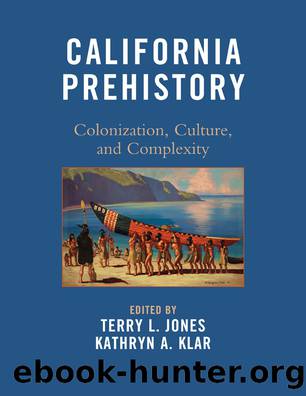California Prehistory by Terry L. Jones

Author:Terry L. Jones
Language: eng
Format: epub
Publisher: AltaMira Press
CHAPTER 14
Prehistory of the Southern Bight: Models for a New Millennium
* * *
BRIAN F. BYRD AND L. MARK RAAB
THE GEOGRAPHICAL FOCUS OF THIS CHAPTER IS Californiaâs Southern Bight, roughly the southern half of the arc extending from the Mexican border to Point Conception. As defined here, this region encompasses Orange and San Diego Counties, western Riverside County, and the offshore islands of Santa Catalina, San Clemente, and San Nicolas (the Southern Channel Islands). At the time of Spanish contact this region was occupied by native groups (Figures 14.1, 14.2) most commonly referred to as the Tongva (Gabrielino), Juaneño (Ajachemen), Luiseño, and Kumeyaay (Bean and Shipek 1978; Bean and Smith 1978; Kroeber 1925; Luomala 1978; McCawley 1996). Our objective in this chapter is to present a regional summary of research on California prehistory since the appearance of Morattoâs (1984) California Archaeology and Chartkoff and Chartkoff âs (1984) The Archaeology of California.
The Southern Bight is remarkably well suited to such a retrospective analysis. This region illustrates a number of important research advances that have been made since the appearance of those two volumes. Data from this area allow us to assess in considerable detail some of the ideas advanced by Moratto and the Chartkoffs. At the same time, however, these studies have generated data that provoke fundamentally different understandings of California prehistory than those in the decades leading up to publication of the two 1984 books. These advances, outlined below, seem likely to propel archaeological research in new directions in the new millennium.
Though they expressed differing perspectives, California Archaeology and the Archaeology of California were the most comprehensive and also the first statewide syntheses of California prehistory. Both appeared at a time when California archaeology was on the cusp of enormous changes. Following the 1970s, the field experienced an explosive proliferation of archaeological information under the aegis of contract archaeology, the âradiocarbon revolution,â and the appearance of a large cadre of archaeologists holding diverse theoretical viewpoints. The result, signaled by the appearance of the two books, was the rise of California archaeology as an intellectual force in its own right. They not only reflected the transformation of California archaeology but also sketched pathways along which research would develop over the following two decades, posing interesting questions about the nature and timing of prehistoric culture change. Chartkoff and Chartkoff (1984), for example, emphasized broad patterns of progressive cultural development, culminating in Late Holocene cultural climaxes characterized by high degrees of adaptive success. By contrast, Moratto (1984:460â464) suggested that culture change may have been more regionally and temporally variable than previously thought, and included episodes of culture change caused by such factors as climatic stresses. One of the most prescient questions posed by Moratto (1984:104â113) was whether a Paleo-Coastal Tradition actually had existed along the California coastline during the Early Holocene, breaking sharply with traditional views of seafaring and intensive maritime adaptations as Late Holocene developments. In the discussion that follows, we point out the ways in which researchers working in the Southern Bight
Download
This site does not store any files on its server. We only index and link to content provided by other sites. Please contact the content providers to delete copyright contents if any and email us, we'll remove relevant links or contents immediately.
Chaco's Northern Prodigies : Salmon, Aztec, and the Ascendancy of the Middle San Juan Region after AD 1100 by Paul F. Reed(356)
Law Enforcement Interpersonal Communication and Conflict Management by Brian Douglas Fitch(349)
Digital International Relations by Unknown(348)
Critical Perspectives on Human Security : Rethinking Emancipation and Power in International Relations by David Chandler; Nik Hynek(330)
Skilled interpersonal communication: Research, theory and practice, Fifth edition by Owen Hargie(328)
The Enduring Color Line in U.S. Athletics by Krystal Beamon Chris M. Messer(326)
Evidence-Based Policy Making in Labor Economics by Hamermesh Daniel S.;Nottmeyer Olga K.;Nottmeyer Olga;King Sarah;King Sarah;King Sarah;(299)
EPSO CAST Political affairs EU policies: How to succeed in the selection procedure by Franco Reverte José María(293)
Writing Public Policy - A Practical Guide to Communicating in the Policy Making Process by Catherine F. Smith(272)
Criminological Theory in Context by John Martyn Chamberlain(271)
Tibeton Yoga Its Secret Doc by Evans-Wentz(268)
Threshold Concepts in Women's and Gender Studies by Christie Launius Holly Hassel(266)
Rothschild and Early Jewish Colonization in Palestine (Geographical Perspectives on the Human Past) by Ran Aaronsohn(266)
Social Problems, Social Issues, Social Science by James Wright(261)
Positive Psychology and Spirituality in Counselling and Psychotherapy (Conflict, Ethics, and Spirituality, 12) by unknow(261)
Play in child development and psychotherapy: toward empirically supported practice by Sandra W. Russ(254)
Cognitive Development in Infancy and Childhood (Elements in Child Development) by Mary Gauvain(253)
Latin American Politics and Society by Gerardo L. Munck & Juan Pablo Luna(224)
What Makes a Social Crisis?: The Societalization of Social Problems by Jeffrey C. Alexander(220)
